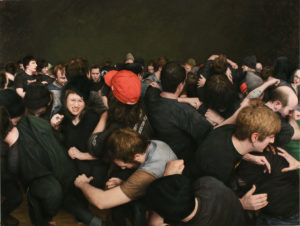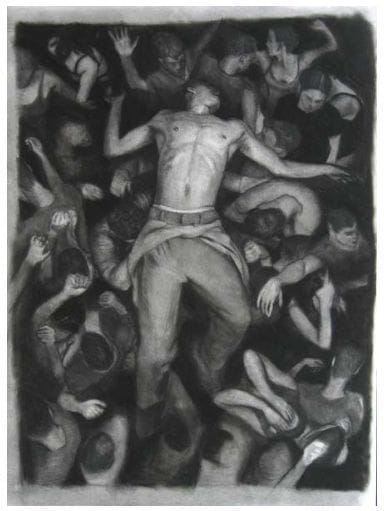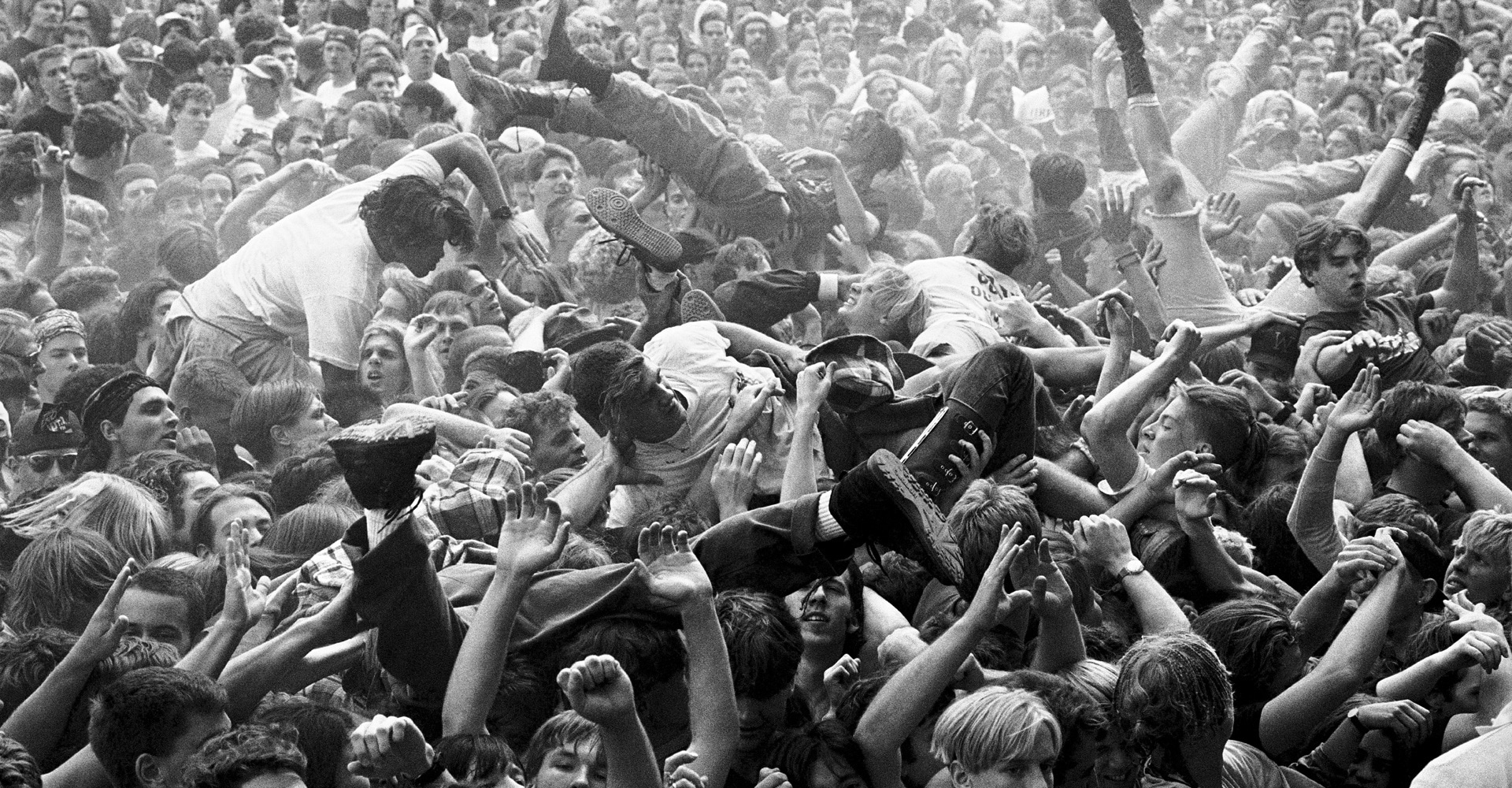Dikeou Superstars: Janine Gordon

Janine Gordon, AFI, 2001, silver gelatin print
The early 2000s: The era of boy bands, pop divas, blinged out rappers, and middle of the road alt rockers. In the midst of this music-for-the-masses arena one genre stood apart, like a big middle finger eager to burst the bubbly world of Pop: Metal. System of a Down, Rage Against the Machine, Disturbed, Slipknot, and Linkin Park dominated the airwaves and the Billboard charts, stomping the Britneys and Justins with ease. This “New Wave of American Metal” was fast, aggressive, and loud with dynamic musicians who knew exactly how to rile up their fans and unleash their angst. The crowds at live shows are quintessential representations of primal energy at its physical and psychological apex, and Janine Gordon captured the intensity with her camera to create her photographic “DIRT” series on view at Dikeou Collection. Gordon’s focus on the people in the audience shows that they were just as charismatic as the performers on stage, and, as a collective fandom, just as socially and culturally powerful.
The concerts Gordon attended took place at Randall’s Island in New York in 2001 and 2002, a time before everyone’s hands and eyes became glued to a smartphone. The body and mind were free to experience the music and the energetic environment without distraction, creating a perfect photographic atmosphere with no inhibition or distraction. She approached her subjects like a journalist, putting herself in the center of the action which “allows us to see the fury, the motion, the aggression, the camaraderie, the unity, and the spirit of a team/teenage life, angst, and revolution…” (Devon Dikeou, curatorial statement). Gordon’s photos serve as documentation of a specific sect of society, and the concert becomes a ritual ground where members of the sect perform a prescribed series of actions, primarily adulation of the music through movement.

Janine Gordon, Surfing, 2002, silver gelatin print
The figures in Gordon’s photographs are in the throws of the mosh pit. Whether circling, skanking, crowd surfing, stage diving, pogoing, or doing windmills, those who partake in this activity do so not with the intention to hurt others, but are accepting and forgiving of pain. Gordon states it’s one of the “dirtiest dances that youth culture embraces today,” but the pit really is a thing of beauty in its own right. Individual people coalesce into a swirling entity of humanity. There is no room for ego or vanity, and gender, religion, and sexuality mean nothing. Everybody is equal.
Naturally, mosh pits would not exist without the bands whose music incited such a concept. The early hardcore punk band Scream’s 1982 song “Total Mash” (which they pronounced as ‘mosh’), defined the ethos behind moshing in the lyrics: “Let me reach out and grab your heart / There’s no reason for you to stand apart / Prefab notions that hold your motions back / Cuts off your head, and tells you how to act.” Then there’s Penelope Spheeris’ seminal 1981 documentary “The Decline of Western Civilization,” which offered mainstream audiences one of the first looks at the punk and later hardcore and metal subcultures.

Dan Witz, 70 Commercial St, 2012, oil and digital media on canvas
The heaving allure of mosh pits and its participants have piqued the interest of artists who work in a variety of media. Dan Witz has created dozens of photorealistic mosh pit paintings that exhibit the same Baroque exuberance as a composition by Rubens, creating a compelling combination of classical, academic sensibility with chaotic and rebellious subject matter.

Bryan LeBoeuf, Mosh Pit (study), 2000, charcoal on paper
Artist Bryan LeBoeuf’s illustration of a figure crowd surfing exemplifies the state of physical and mental surrender one succumbs to while in the heart of the mosh pit. The overhead perspective and languid anatomy is like witnessing, or undergoing, an out of body experience.

Charles Peterson, Mosh Pit at Endfest, Kitas County, Washington, 1991
Charles Perterson, well known for documenting the grunge scene of the early 1990s, directed his camera toward the sea of bodies at intimate shows and large festivals alike, proving that no crowd or venue is too small or too big to instigate such a frenzy.

Janine Gordon, Plant Your Feet, 2001, silver gelatin print
Janine Gordon captured moments that are damn near divine within the hedonistic mass that is the mosh pit. Her ability to hone in on an individual within the group highlights how the singular intensity of one person has a ripple effect, creating a collective energy enhanced by the music. She bravely integrates herself into the pit to capture these moments, while other photographers would likely work from a more comfortable distance. The clouds of dirt kicked up from the movement of the crowd got into in her camera and developed into the film, creating an atmospheric effect and adding that conceptual layer and authenticity to the powerful “DIRT” series.
— Hayley Richardson
